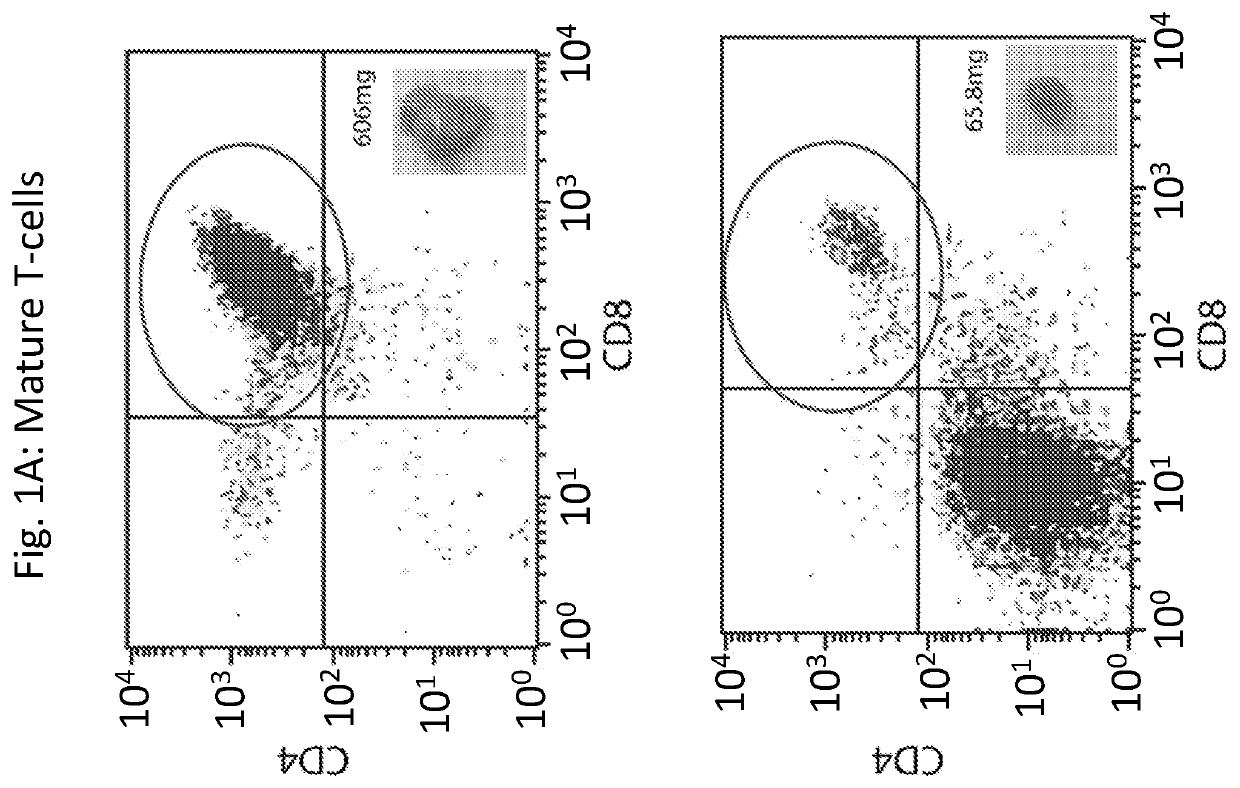Novel immunodeficient rat for modeling human cancer
a technology of immunodeficiency and rat, which is applied in the field of new immunodeficiency rat for modeling human cancer, can solve the problems of limited mouse model use, drug efficacy studies are difficult, and the inability to perform serial sampling of tumors and blood for pharmacodynamics
- Summary
- Abstract
- Description
- Claims
- Application Information
AI Technical Summary
Benefits of technology
Problems solved by technology
Method used
Image
Examples
example 1
[0063]Generation of Rag2- and Rag2 / IL2RG-Knockout Sprague Dawley Rats
[0064]For the single knockout, the Rag2 locus was targeted using XTN™ technology in spermatogonial stem cells (SSCs). Pooled SSCs were transplanted into DAZL-deficient sterile males and mated with wild-type Sprague Dawley rats. DNA was isolated from offspring and a male with a 27 bp deletion was detected.
[0065]For the double-knockout, the Rag2 and Il2rg loci were targeted using CRISPR. CRISPR based targeted nuclease reagents targeting the Rag2 and Il2rg genes were microinjected into Sprague Dawley embryos at the 2-cell stage. A total of 314 embryos were injected, of which 187 were successfully transferred into pseudopregnant surrogates. 32 animals were born of which, 9 animals carried at least one mutated allele verified by targeted sequence analysis. These founders were interbred to create the Rag2.I2rg double knockout animal (Rag2− / −, IL2rg− / −), which contains an 8 bp homozygous deletion in the Rag2 gene (atatggc...
example 2
[0069]Improved Human Non-Small Cell Lung Cancer (NSCLC) Tumor Engraftment and Kinetics in Rag2 KO Rats
[0070]The Rag2 knockout, demonstrated improved tumor growth kinetics and engraftment rate for H358 xenografts. A KRAS mutant non-small cell lung cancer (NSCLC) cell line H358 was implanted into Rag2 KO rats subcutaneously. 1, 5, or 10 million cells (H358 human non-small cell lung cancer cells) were mixed with Geltrex® 1:1 and transplanted subcutaneously in the hind flank. Tumors were measured three times weekly and recorded in StudyLog to determine tumor growth kinetics.
[0071]The tumor growth was faster and more consistent when compared to NSG and Nude Mice (FIG. 4). A 100% tumor engraftment rate observed was observed in the Rag2 KO rats, compared to less than 20% successful engraftment rate in immunodeficient mice. Tumor kinetics were also much better in the Rag2 KO rat: the growth curve of the tumor within a treatment group were much closer to each other than what was observed in ...
example 3
[0076]Enhanced Growth with HCT-116 Xenograft Model in the ILR2g and Rag2 KO SCID Rat Vs. NSG Mouse.
[0077]We also assessed the ability of the HCT-116 xenograft to form tumor xenografts.
[0078]For transplantation, 2×106 HCT-116 cells for each animal (NSG mice and ILR2g and Rag2 KO rats) were resuspended in 250 μl sterile 1×PBS (Gibco #14190-144). Immediately prior to injection, 250 μl 10 mg / ml Cultrex BME3 (Trevigen #3632-001-02) was added to the cell suspension for a final Cultrex concentration of 5 mg / ml. The cell / Cultrex suspension was injected subcutaneously into the hindflank. Tumor diameter was measured using digital calipers (Fisher #14-648-17) 3 times a week. Tumor volume was calculated as (L×W2) / 2, where width and length were measured at the longest edges.
[0079]FIG. 7A shows tumor kinetics in 5 NSG mice. Each line represents an individual mouse. FIG. 7B shows tumor kinetics in 5 ILR2g and Rag2 KO rats, where each line represents an individual rat. FIG. 7C provides a comparison...
PUM
| Property | Measurement | Unit |
|---|---|---|
| Fraction | aaaaa | aaaaa |
| Time | aaaaa | aaaaa |
| Volume | aaaaa | aaaaa |
Abstract
Description
Claims
Application Information
 Login to View More
Login to View More - R&D
- Intellectual Property
- Life Sciences
- Materials
- Tech Scout
- Unparalleled Data Quality
- Higher Quality Content
- 60% Fewer Hallucinations
Browse by: Latest US Patents, China's latest patents, Technical Efficacy Thesaurus, Application Domain, Technology Topic, Popular Technical Reports.
© 2025 PatSnap. All rights reserved.Legal|Privacy policy|Modern Slavery Act Transparency Statement|Sitemap|About US| Contact US: help@patsnap.com



